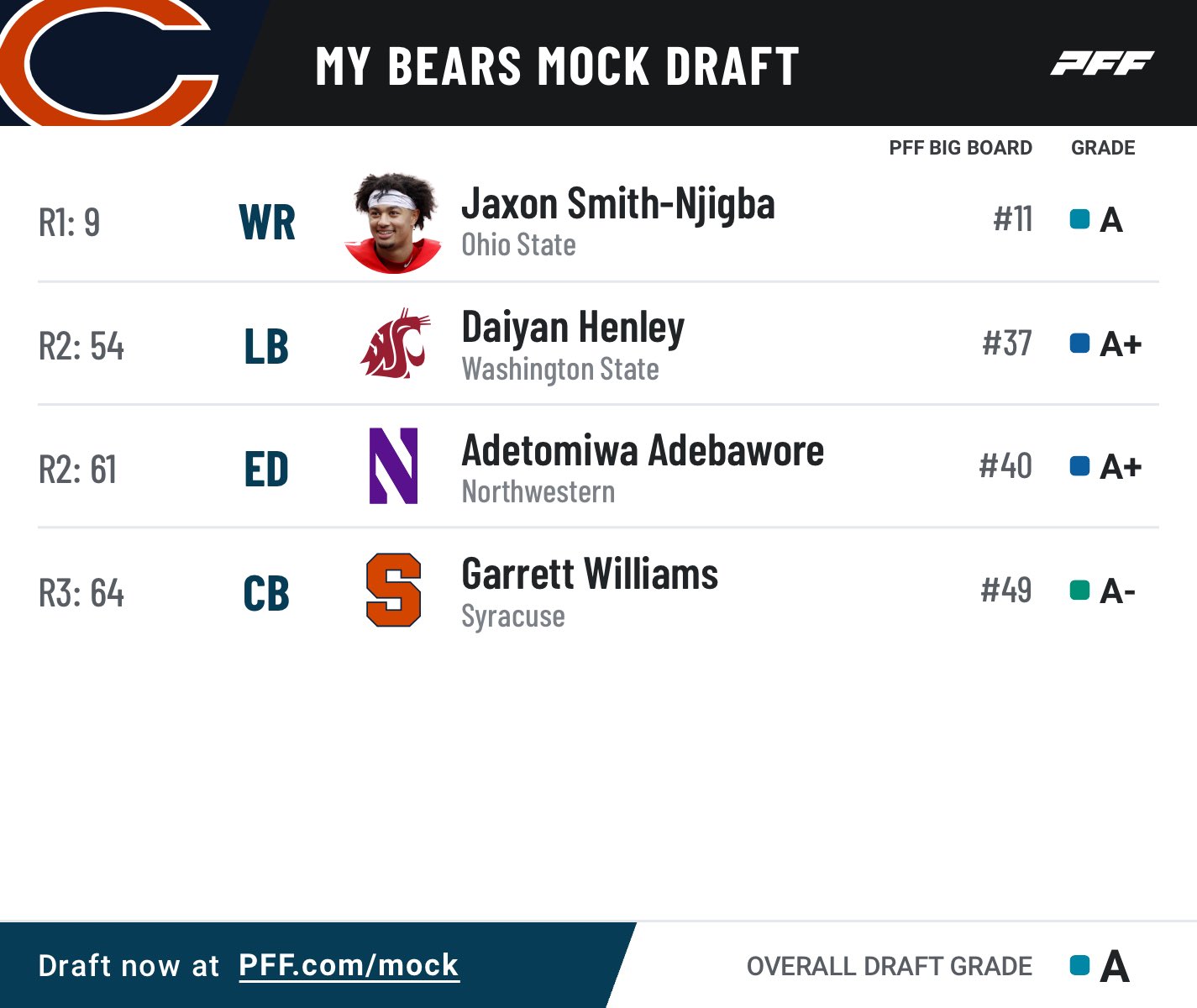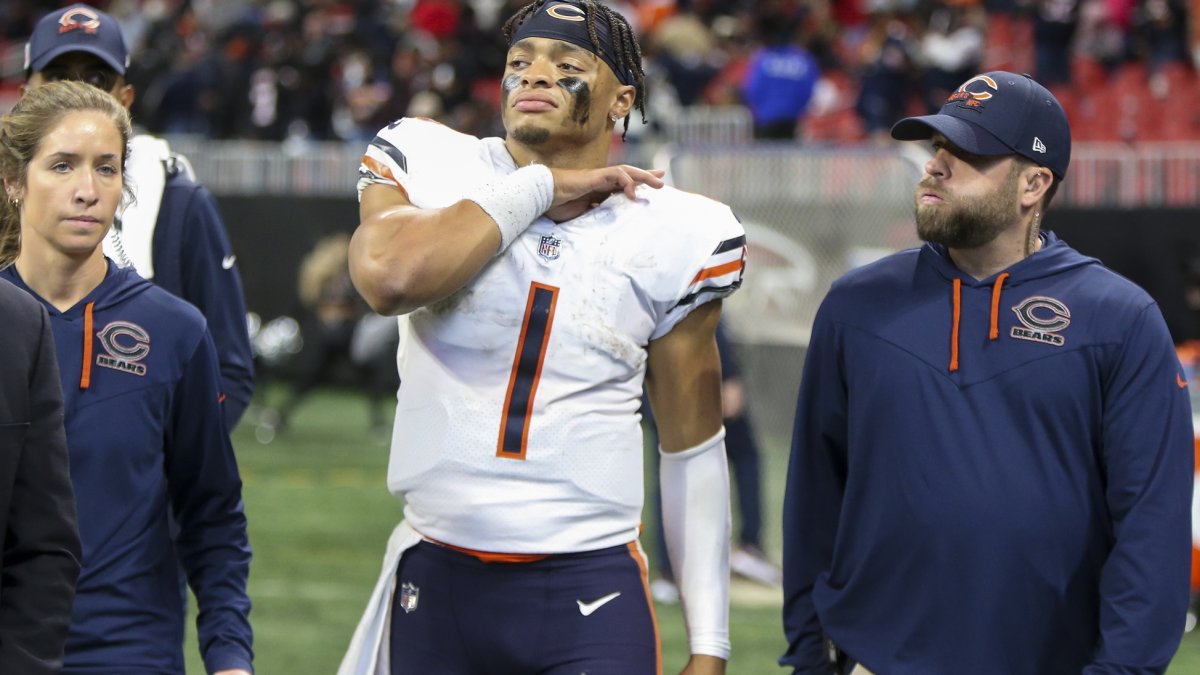• How does the deal compare to recent trades? The Panthers gave up a little bit less than the Commanders (2012) and Rams (2016) did when they traded up to select their QBs of the future. However, Carolina has given a lot more than the Eagles (2016) and 49ers (2021) did.
• Bears commit to quarterback Justin Fields: The Bears traded out of range of the top quarterbacks in the draft and added a top receiving weapon to Fields' arsenal in the process.
• Panthers on the clock: Research has shown that teams often struggle to make the right choice when it comes to drafting the best player from a group of prospects who are similarly viewed by the consensus. In fact, teams get it right at a rate that is only unnoticeably better than guessing.
• The price of the move requires a big swing: The median outcome is a net negative for the Panthers, so the whole trade is a bet on upside, as drafting a merely tolerable quarterback isn’t enough to justify the investment. Anthony Richardson‘s combination of arm strength and otherworldly athletic ability would provide the necessary ceiling to turn the risky trade into a net gain.
Estimated reading time: 10 minutes
The 2023 NFL Draft got its first major shakeup last Friday when the Chicago Bears agreed to trade the first overall pick to the Carolina Panthers.
It didn’t take long for the details to emerge: The Panthers will receive the No. 1 pick, and the Bears will receive:
- Pick No. 9 in the 2023 NFL Draft
- Pick No. 61 in the 2023 NFL Draft
- A 2024 first-round pick
- A 2025 second-round pick
- D.J. Moore on a three-year deal worth $52.3 million
Additionally, the Panthers will pay $14.6 million in dead cap for Moore in 2023.
With the move down, the Bears signaled a resounding commitment to quarterback Justin Fields, as they traded out of range of the top quarterbacks in the draft and added a top receiving weapon to Fields' arsenal in the process.
To further support their former first-round passer, the chances are high that Chicago selects an offensive lineman with the ninth overall pick, as one of the top tackle prospects Paris Johnson Jr. or Peter Skoronski is very likely available at this spot.
Meanwhile, the Panthers are now on the clock and have an opportunity to find their quarterback of the future. But research has shown that teams often struggle to make the right choice when it comes to drafting the best player from a group of prospects who are similarly viewed by the consensus. In fact, teams get it right at a rate that is only unnoticeably better than guessing.
This year, the advantage of choosing first is even smaller than usual, as Bryce Young, C.J. Stroud, Anthony Richardson and Will Levis have all been selected first in recent mock drafts, and we can be almost certain that each of those players will be the top-ranked quarterback on at least one team’s board.
So, given that there are four top-tier quarterbacks available and that teams are wrong nearly 50% of the time when it comes to correctly choosing between two prospects, we can be very confident that the Panthers’ chance of selecting the best among those four quarterbacks is 35-40% at best. And that's assuming that their scouting department is doing an excellent job.

Comparison to other trades to the top of the draft
We can compare this trade to a few recent transactions:
• The Washington Commanders‘ move up to No. 2 to select Robert Griffin III in 2012 (it was widely known that the Indianapolis Colts would select Andrew Luck with the first overall pick that year).
• The Los Angeles Rams‘ move up to No. 1 to select Jared Goff in 2016.
• The Philadelphia Eagles‘ move up to No. 2 to select Carson Wentz in 2016.
• The San Francisco 49ers‘ move up to No. 3 to select Trey Lance in 2021.
Here is what these teams gave up:
| Commanders | Rams | Eagles | 49ers |
| No. 6 | No. 15 | No. 8 | No. 12 |
| No. 39 | No. 43 | No. 77 | Future first-rounder (+1) |
| Future first-rounder (+1) | No. 45 | No. 100 | Future third-rounder (+1) |
| Future first-rounder (+2) | No. 76 | Future first-rounder (+1) | Future first-rounder (+2) |
| Future first-rounder (+1) | Future second-rounder (+2) | ||
| Future first-rounder (+2) | Received future fifth-rounder in return | ||
| Received No. 113 in return + 177 |
To compare these trades using the Jimmy Johnson Chart — the standard for NFL draft trades today — we have to set a trade value for D.J. Moore.
The Packers reportedly offered a first-round pick for Moore at the trade deadline, but the value during the trade deadline is typically slightly higher because teams tend to panic. This is especially true for the Packers in this instance, as they were in dire need of a wide receiver after trading away Davante Adams, and Aaron Rodgers was playing well beneath the standards he had set during his MVP seasons of 2020 and 2021.
The Packers' brass likely thought that trading for Moore would push the team into the postseason, so they probably assumed that they would be offering a pick in the 20s.
After adjusting for the increased value during the trade deadline, Moore’s trade value can be considered to be in the 30s — an early second-round pick — so we set it at 35, which gives us a value of 550 on the Jimmy Johnson Chart.
Therefore, the total Jimmy Johnson value the Panthers had to give up computes as follows:
2023 value: 1,350 (No. 9) + 292 (No. 61) + 550 (No. 35/Moore) = 2,192
Future value: 1,000 (Future first) + 420 (Future second) = 1,420
Let’s look at the other trades by simply translating the picks in the table above to their respective Jimmy Johnson values:
| Commanders | Rams | Eagles | 49ers |
| 1,600 | 1,050 | 1,400 | 1,200 |
| 510 | 470 | 205 | 1,000 (future) |
| 1,000 (future) | 450 | 100 | 190 (future) |
| 1,000 (future) | 210 | 1,000 (future) | 1,000 (future) |
| 1,000 (future) | 420 (future) | ||
| 1,000 (future) | -35 (future) | ||
| -90 |
The total value given up adds up to:
- Commanders: 2,110 + 2,000 future value
- Rams: 2,090 + 2,000 future value
- Eagles: 1,305 + 1,385 future value
- 49ers: 1,200 + 2,190 future value
The Panthers gave up the most immediate value, which they will miss when it comes to supporting their new young quarterback. The Commanders and Rams gave up more future value, which is generally discounted slightly in these trade computations.
When combining immediate and future value given up, the Panthers gave up a little bit less than the Commanders and Rams, but they gave up a lot more than the Eagles and 49ers.
Consequently, the Panthers paid a price that either aligns right with the recent market or is even a little bit above that.
Given that there are four quarterbacks at the top of the draft, the value of the No. 1 overall pick is a little bit lower than it was for the other teams. But because they paid a similar price to get it, it is not a good deal for the Panthers, according to the recent market. Conversely, it is a very good deal for the Bears.
An on-field value analysis
Another way to analyze the trade is by looking at the projected on-field value of the involved assets. To calculate this, we can use the projected PFF WAR of draft picks.
Exclusive content for premium subscribers

WANT TO KEEP READING?
Dominate Fantasy Football & Betting with AI-Powered Data & Tools Trusted By All 32 Teams
Already have a subscription? Log in




 © 2025 PFF - all rights reserved.
© 2025 PFF - all rights reserved.